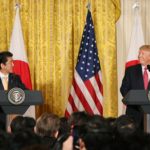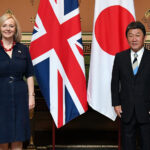
The aircraft carrier USS Ronald Reagan in Yokosuka, Kanagawa Prefecture, Japan
Former Maritime Self-Defense Force Fleet Commander Koda Yoji shares his thoughts.
The current conditions in the South China Sea, an area that has been attracting global attention since last year, can be called a product of China’s underhanded strategies for turning the concentrated international interest in antagonism between Japan and China over the Senkaku Islands to its own advantage.
China, which had had no effective military foothold in the southern part of the South China Sea, has attempted to build man-made islands and military bases on the Spratly Islands (hereinafter referred to as the “man-made island preparation”) by reclaiming reefs there, using the situation in the East China Sea as cover. The United States, which must have known about the man-made island preparation, refrained from demanding that China exercise self-control until the beginning of last year. Interpreting this stance as tacit approval by the United States, China accelerated the man-made island preparation, ignoring the opposition of countries facing the South China Sea.
Feeling uneasy about the rapid progress of the man-made island preparation, the U.S. administration led by President Barack Obama turned its policy around at the beginning of last year. The administration informed the world about the current conditions in the South China Sea through means including CNN reports and statements made by the U.S. Secretary of Defense, and asked China to stop construction immediately. With these steps as a turning point, criticism mounted worldwide, forcing China to issue a statement on the termination of construction work and the suspension of subsequent facility construction at one point. Contrary to these developments, however, China has been showing no signs of suspending the man-made island preparation.
Current Conditions in the South China Sea
In addition to the Paracel Islands, over which China had exercised effective control, China reclaimed land to form man-made islands, consisting of a main base (on the Fiery Cross Reef) supplied with an air base with a 3,000-meter runway and a harbor, two sub bases (on the Subi Reef and the Mischief Reef) and four surrounding atolls, in the Spratly Islands that had had no usable acreage.
Countries facing the South China Sea, such as the Philippines and Vietnam that were deprived of their reefs, had no power to oppose China directly. Despite expectations, a top-level meeting between U.S. and Chinese leaders in September 2015 only aggravated the confrontation between the United States, which sought to suspend the man-made island preparation, and China, which positioned it as a domestic issue. China turned a deaf ear to the demilitarization of the man-made islands, on which the two countries appeared to have agreed, maintaining that the deployment of radars and the like is a self-defense measure that differs from militarization in essence. China thereby created a fait accompli. In opposition to the U.S. demand, China is arguing that the United States is responsible for advancing militarization in the South China Sea, citing U.S. military deployment in the South China Sea, monitoring activities, and joint military exercises with countries facing the Sea.
Surveying activities by China were confirmed for the first time at Scarborough Shoal, which is located west of Luzon Island, in March 2016 as competition between the United States and China over the South China Sea became deadlocked. As developments like this suggest, the man-made island preparation on the Shoal is taking on a touch of real possibility. The situation is becoming increasingly tense.
U.S. Responses and Their Limits
In view of these existing conditions, the Obama administration went ahead with the execution of the Freedom of Navigation Operation (FONOP), employing destroyers and bombers from the end of October 2015 after the Sino-U.S. summit. Freedom of Navigation (FON) is a basic state principle that has guided the United States to the position of a superpower. FON is also a basis for the international law of the sea, which guarantees the freedom of all marine activities in international waters (including navigation and the development of marine resources). The United States positions FON as a national interest and regards it as a basis for its stand on problems in the South China Sea.
There are no grounds for the United States, a country outside the region adopting neutrality in territorial disputes between third nations as its state policy, to intervene in the current territorial dispute in the South China Sea. In the meantime, the United States is considering FON as a basis for its interventions in the problems found in the South China Sea, stating, “Disputes between third countries that obstruct free sea traffic in the South China Sea could infringe on the national interests of the United States.” This U.S. position has been one of the axes of confrontation with China, which maintains, “The United States is an outside country that is not qualified to intervene.”
As specific actions based on its rebalancing policy, the United States is also taking steps such as the deployment of P-8 patrol planes in Singapore, in addition to the deployment of the new and powerful aircraft carrier USS Ronald Reagan in Yokosuka and littoral combat ships, in quick succession. These steps are expected to repress China’s military adventurism to a certain extent. These U.S. operations suggest China’s misadministration that resulted from its own high-handed actions. They resemble an own goal. They have brought China’s isolation in the global community into sharp focus.
However, the U.S. policy is also showing its limits. China has been arguing that the man-made island preparation is a national defense issue. In the meantime, the United States has been unable to come up with an effective measure for stopping the man-made island preparation that directly affects the existing conditions in the South China Sea. It appears to be only a matter of time before China establishes an air defense identification zone in the South China Sea.
Measures That Should Be Taken
There is no remedy that can confine China’s self-righteous maritime expansion. However, steady and concerted countermeasures taken by the countries concerned could become symptomatic treatment. In particular, strong cooperation by the countries concerned is indispensable for preventing their division and destruction one by one, which are familiar tactics adopted by China.
The next idea is to appropriate strategic places near the South China Sea that are more strategically valuable than the man-made islands, such as Cam Ranh Bay in Vietnam, and Luzon Island and Palawan Island in the Philippines, for U.S. military use. This action would give the U.S. armed forces a powerful and constant presence. It could help the recovery of the strategic balance that leaned toward China.
The development of an information sharing network for raising observation and surveillance capabilities lacking in countries facing the South China Sea is also an idea for these countries to build air and sea monitoring systems under Japanese-U.S. assistance and share information among themselves. Such a network would enable them to detect China’s marine activities and take deterrent actions promptly.
China’s plan to build a man-made island in the Scarborough Shoal is a case that now requires urgent measures. The Shoal is untouched at the moment, but a strategic triangle connecting the Paracel Islands and the Spratly Islands with the Shoal and covering the entire central section of the South China Sea will be formed when the man-made island is completed. When that happens, the strategic balance in the South China Sea will deteriorate to a level that Japan and the United States cannot tolerate. The countries concerned, including Japan and the United States, must prepare measures widely in advance, from summit conferences and diplomatic negotiations to the use of force based on the FON as the final step, in order to stop China’s self-righteous activities. They must clearly communicate to China their intention to execute the optimum plan when doing so is necessary.
The implementation of the measures stated above is essential to avoid a repetition of the mistakes made in the Spratly Islands.
KODA Yoji is a former Maritime Self-Defense Force Fleet Commander.








